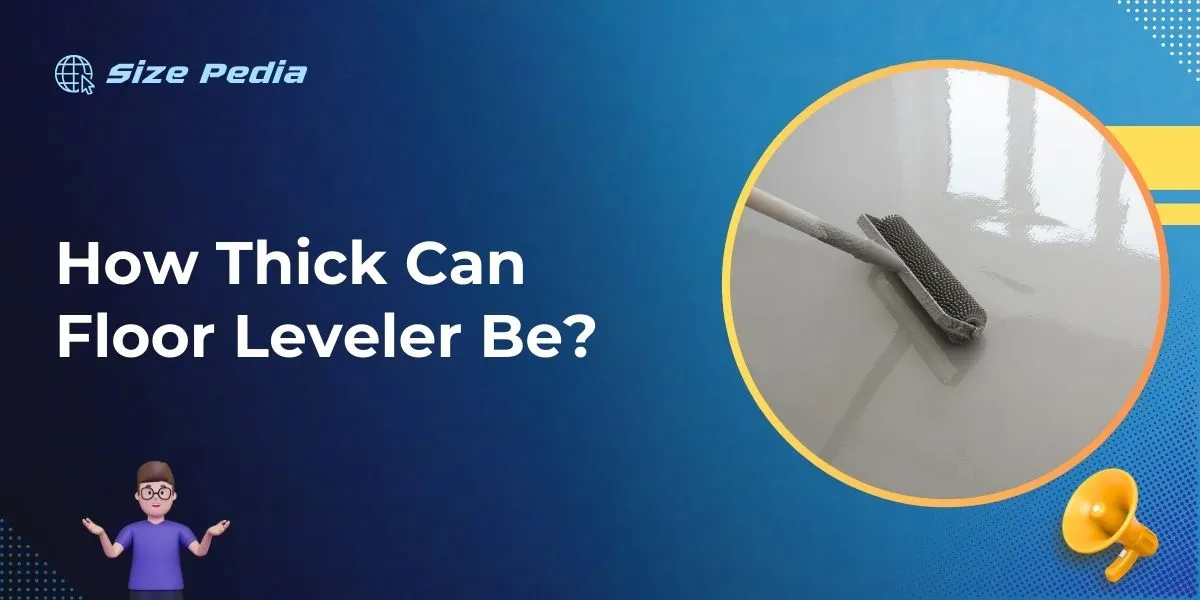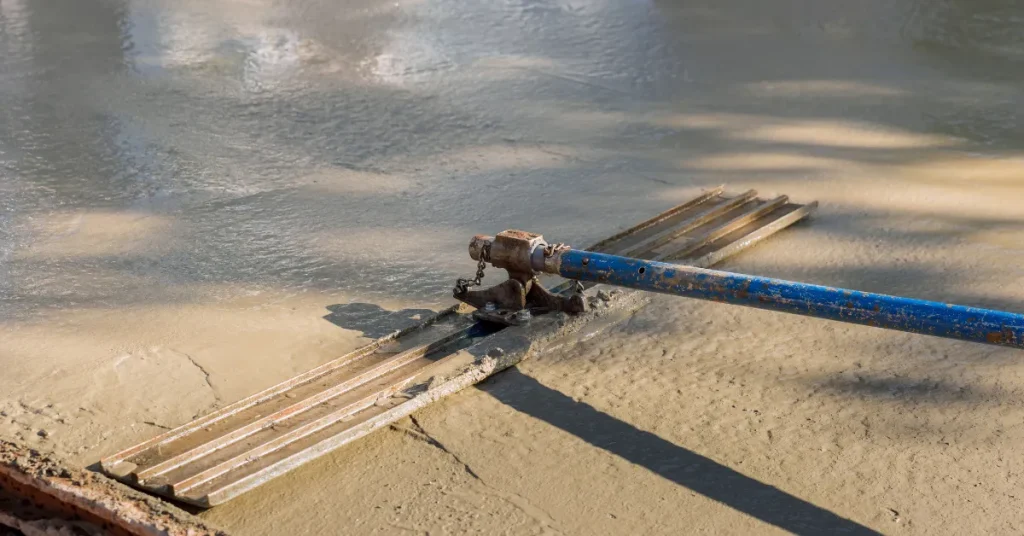Floor leveler can vary in thickness from 1/8 inch to 1 inch. Some products can extend up to 5 inches with proper aggregate.
Achieving a perfectly level and smooth base for your flooring is crucial for a successful installation. Floor levelers are designed to fill in imperfections and create a uniform surface. Their thickness can depend on the product and the depth of the irregularities in the subfloor.
Homeowners and contractors often seek the best solutions for leveling floors before laying tiles, linoleum, wood, or other flooring materials. It is essential to choose a floor leveler that suits the requirements of your project, ensuring durability and stability.
Remember to always follow the manufacturer’s guidelines for the best results. Selecting the right thickness of floor leveler can prevent future issues, such as cracking or uneven flooring, which can ultimately save time and money.

Unveiling Floor Leveler
Imagine a puzzle with uneven pieces; that’s a floor without leveler. Floor leveler acts like magic, smoothing out dips and rises. It sets the stage for flooring that’s not just beautiful, but safe and long-lasting too. Let’s explore this unseen hero of flawless floors.
What Is A Floor Leveler?
Floor leveler is a compound that creates a flat surface for flooring. It fills in gaps and makes sure your floor is even. There are different kinds, like quick-dry or deep-fill. Without it, your floor might feel like a bumpy road.
Importance Of Proper Depth
The right thickness for a leveler is key. Too thin, and it won’t fix the dips. Too thick, and it might crack. The manufacturer tells you the best thickness. Usually, it’s no more than an inch. But in deep gaps, it can be more. Let’s break down why proper depth matters:
- Stability: The correct depth keeps your floor stable.
- Durability: It ensures your floor lasts longer.
- Flexibility: Some areas need more leveler to be just right.
Always check the label for maximum depth. And remember, patience is your friend when it comes to drying time.
Types Of Floor Levelers

Choosing the right floor leveler is crucial for a smooth, even surface. Understanding the different types and their maximum thickness is key to a successful installation.
Whether renovating an old house or constructing a new one, floor levelers provide a leveled base for flooring.
Self-leveling Compounds
Self-leveling compounds are a go-to for many professionals. These materials are designed to flow freely and create a flat surface without much manual intervention. Ideal for use over concrete and plywood, they come in various formulas, each with a specific thickness range.
Commonly, these compounds can be applied at thicknesses from 1/8 inch to 1 inch, with some specialized products allowing up to 2 inches in depth.
- Quick to apply and dry
- Minimal effort for leveling
- Available in both standard and deep-fill options
Traditional Underlayments
Traditional underlayments, such as cement-based backer boards, represent a different approach. They are solid sheets that you cut to size and install. These are not fluid like self-leveling compounds but provide excellent stability for tile and stone flooring. When dealing with thickness, traditional underlayments might range from 1/4 inch to over 1/2 inch.
| Type | Material | Thickness Range |
| Self-Leveling Compounds | Various resins or cement-based | 1/8 inch to 2 inches |
| Traditional Underlayments | Cement board, plywood, etc. | 1/4 inch to 1/2 inch |
When used properly, both self-leveling compounds and traditional underlayments create the ideal foundation for your flooring choices. Opting for the right type ensures longevity and durability of your floor without worry.
Determining Max Thickness
Ensuring the correct thickness of floor leveler is crucial for a stable and solid surface. Choosing the right depth prevents cracks and ensures durability. Let’s dive into how to determine the maximum thickness for floor levelers.
Manufacturer Specifications
The first step is consulting the product’s manual. Different brands have unique specifications. These guidelines offer precise thickness ranges. Following these ensures effective application.
Important to note:
- Maximum thickness per layer
- Cure times for various depths
- Need for reinforcement at thicker levels
Factors Affecting Thickness
Several variables influence the thickness at which you can apply floor leveler. Knowing these ensures the right mix and application.
| Factor | Impact on Thickness |
| Subfloor Material | Different materials bond uniquely with levelers. |
| Leveler Type | Some varieties are designed for thin applications, others for thick. |
| Area Size | Larger areas might require a thicker application for uniformity. |
| Desired Finish | Thicker layers can smooth out more significant imperfections. |
Always measure accurately and mix consistently for the best results. This prevents problems and ensures a level floor ready for any finish.
Application Techniques
When applying floor leveler, the right techniques make all the difference. Thickness plays a crucial role in end results. Dive into the application process for a flawless surface preparation.
Preparatory Steps
Before pouring any leveler, a clean, debris-free surface is vital. Proper preparation ensures maximum adhesion and a smooth, level finish. Here are key steps:
- Clean the floor from any dust, oils, or contaminants.
- Repair cracks or holes with a suitable patching compound.
- Prime the surface if required by the product manufacturer.
Professional Vs. Diy Applications
| Professional | DIY |
| Uses advanced equipment and materials. | Relies on readily available tools and levelers. |
| Often handles larger, more complex jobs. | Suitable for small areas or minor repairs. |
| May achieve more consistent thickness. | Requires careful application to ensure even coverage. |
In both professional and DIY, follow manufacturer guidelines for best results. Remember, layer thickness generally should not exceed the product’s specified maximum. DIYers, be bold and meticulous to achieve a surface that looks professionally done.
Troubleshooting Common Issues

Floor leveler helps create a flat surface for flooring. Sometimes, problems happen. This section will help solve common issues when using floor leveler.
Avoiding Cracking And Bubbling
To prevent cracks, ensure proper mixing. Mix the leveler with water as suggested by the manufacturer. Keep the mix consistent. Apply quickly to avoid drying too fast.
Moisture in concrete can cause bubbles. Ensure the surface is dry. Primer can help. Follow manufacturer guidelines for the best results.
- Mix accurately: Use exact water quantities.
- Apply promptly: Work fast to avoid premature setting.
- Dry surface: Remove moisture before application.
- Use a primer: Select the right primer to avoid bubbling.
Measures For Uneven Depths
Deep areas need special attention. Apply floor leveler in layers. Each layer should be no more than 1/4 inch thick. Let each layer dry before the next. Use a straightedge to check evenness.
| Depth (inches) | Layers | Drying Time per Layer | Checking Method |
| 1/4 | 1 | As per product | Use straightedge |
| 1/2 | 2 | As per product | |
| 3/4 | 3 | As per product |
- Layer method: Apply in thin layers, not exceeding 1/4 inch.
- Dry thoroughly: Allow complete drying between layers.
- Evenness check: Use tools like a straightedge for accuracy.
Case Studies
Floor levelers can make or break a flooring project. Case studies show real-life outcomes.
Success Tales Of Perfect Leveling
Professionals and homeowners alike have shared successes with the right thickness of floor leveler.
- John’s Kitchen: Used self-leveling compound up to 1 inch. Achieved a flawless finish for tile installation.
- Bella’s Boutique: Leveled an old shop floor with 2 inches of leveler. Perfectly smooth surface for luxury vinyl.
- The City Library: Applied up to 3 inches in low spots. No more uneven floors troubling visitors.
Lessons From Flooring Failures
Sometimes, floors don’t turn out as planned. Each failure has a lesson.
| Project | Floor Leveler Used | Issue | Lesson |
| Home Gym | Over 3 inches | Cracking | Exceeding limits causes cracks. |
| Office Lobby | 0.5 inches unevenly | Uneven tiles | Consistency is key for evenness. |
| Art Gallery | Scant coverage | Visible high spots | Cover all areas thoroughly. |
FAQs About How Thick Can Floor Leveler Be
What Is The Maximum Thickness Of Floor Leveler?
The maximum thickness for floor leveler typically ranges from 1/2 inch to 1 inch. Always check the product’s specifications for precise limitations.
How Deep Can You Self Level A Floor?
Self-leveling floor compounds typically allow for depths between 1/8 inch to 1 inch. For deeper applications, consult the manufacturer’s instructions as products may vary.
How Do You Level A 2 Inch Concrete Floor?
To level a 2 inch concrete floor, start by cleaning the area thoroughly. Then, mix self-leveling compound as directed by the manufacturer. Pour the compound onto the floor, spreading evenly with a trowel. Allow it to dry completely following the product’s specific drying time guidelines.
Can You Do Multiple Layers Of Floor Leveler?
Yes, you can apply multiple layers of floor leveler, but ensure each layer fully dries before adding the next one. Follow manufacturer guidelines for thickness and layering instructions.
Conclusion
Understanding the limitations of floor leveler is crucial for successful application. A general rule is keeping thickness under a quarter inch.
For thicker layers, choose a product designed for that purpose. Proper preparation ensures a smooth, durable surface. Remember, always follow manufacturer guidelines for best results.
Resources:
1. https://millelacsband.com/rfps/residential-flooring-in-onamia-mcgregor-and-sandstone
